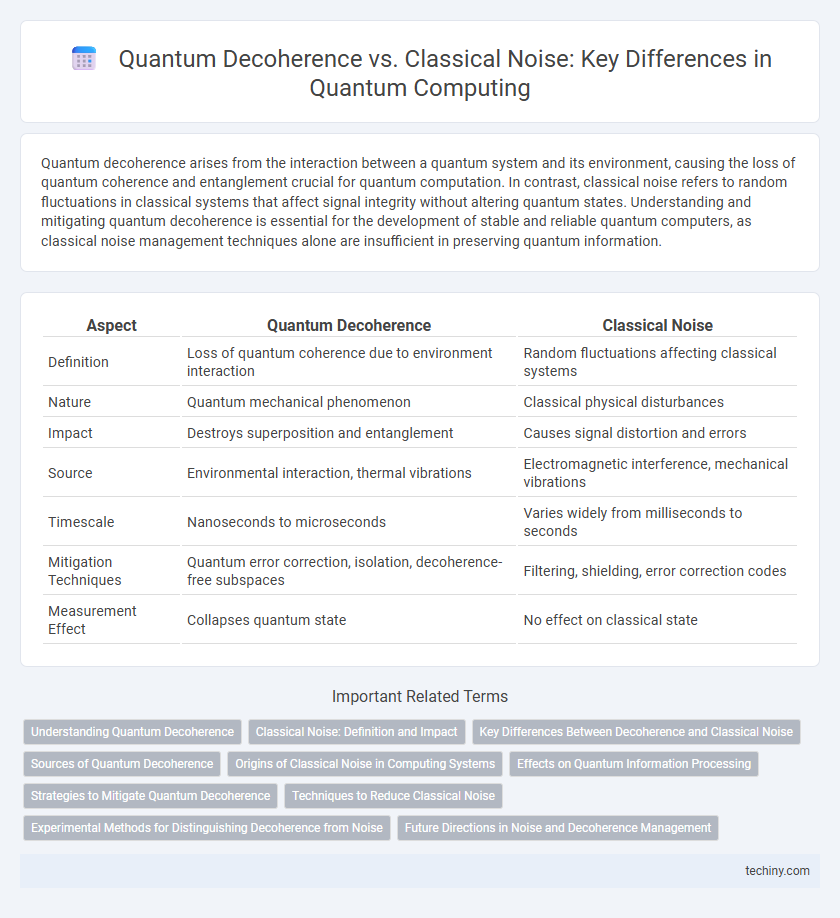Quantum decoherence arises from the interaction between a quantum system and its environment, causing the loss of quantum coherence and entanglement crucial for quantum computation. In contrast, classical noise refers to random fluctuations in classical systems that affect signal integrity without altering quantum states. Understanding and mitigating quantum decoherence is essential for the development of stable and reliable quantum computers, as classical noise management techniques alone are insufficient in preserving quantum information.
Table of Comparison
| Aspect | Quantum Decoherence | Classical Noise |
|---|---|---|
| Definition | Loss of quantum coherence due to environment interaction | Random fluctuations affecting classical systems |
| Nature | Quantum mechanical phenomenon | Classical physical disturbances |
| Impact | Destroys superposition and entanglement | Causes signal distortion and errors |
| Source | Environmental interaction, thermal vibrations | Electromagnetic interference, mechanical vibrations |
| Timescale | Nanoseconds to microseconds | Varies widely from milliseconds to seconds |
| Mitigation Techniques | Quantum error correction, isolation, decoherence-free subspaces | Filtering, shielding, error correction codes |
| Measurement Effect | Collapses quantum state | No effect on classical state |
Understanding Quantum Decoherence
Quantum decoherence arises when a quantum system interacts with its environment, causing the loss of quantum coherence and collapse of superposition states into classical probabilities. Unlike classical noise, which typically results from external disturbances affecting classical signals, quantum decoherence directly impacts the quantum phase relationships essential for quantum information processing. Understanding the mechanisms of decoherence is critical for developing error correction strategies and improving the stability of quantum computers.
Classical Noise: Definition and Impact
Classical noise refers to unwanted external disturbances in quantum systems arising from thermal fluctuations, electromagnetic interference, and mechanical vibrations that disrupt coherent quantum states. This type of noise impacts quantum computing by causing errors in qubit manipulation and reducing the fidelity of quantum gates, leading to computational inaccuracies. Understanding and mitigating classical noise is essential for developing stable quantum processors and enhancing error correction protocols.
Key Differences Between Decoherence and Classical Noise
Quantum decoherence fundamentally arises from the entanglement between a quantum system and its environment, causing the loss of quantum superposition and resulting in the decay of quantum information. Classical noise, in contrast, typically refers to random fluctuations or disturbances affecting classical signals without altering quantum coherence. Key differences include the irreversible collapse of quantum states in decoherence versus the reversible signal degradation in classical noise, and the intrinsic reliance of decoherence on quantum entanglement rather than external random disturbances.
Sources of Quantum Decoherence
Quantum decoherence primarily arises from interactions between qubits and their surrounding environment, causing the loss of quantum coherence and resulting in the transition from quantum to classical behavior. Key sources include electromagnetic fluctuations, thermal vibrations, and material defects that induce phase errors and energy relaxation in quantum systems. Unlike classical noise, which is typically external and can often be filtered, quantum decoherence is intrinsic to the quantum system's entanglement with environmental degrees of freedom, making error correction in quantum computing particularly challenging.
Origins of Classical Noise in Computing Systems
Classical noise in computing systems primarily originates from thermal fluctuations, electromagnetic interference, and inherent material imperfections in hardware components. These sources induce random errors and signal distortions, impacting the reliability of classical information processing. Unlike quantum decoherence, which arises from quantum system-environment entanglement, classical noise is driven by macroscopic physical disturbances external to the computational state.
Effects on Quantum Information Processing
Quantum decoherence causes the loss of quantum coherence by entangling quantum states with the environment, leading to errors in quantum information processing that degrade qubit superposition and entanglement. Classical noise, typically characterized by random fluctuations in external parameters, introduces errors through unwanted disturbances but does not fundamentally disrupt quantum states like decoherence. Mitigating quantum decoherence is critical for high-fidelity quantum computation, as it directly impacts error rates, gate operations, and the overall stability of quantum algorithms.
Strategies to Mitigate Quantum Decoherence
Quantum decoherence, the loss of quantum information due to environmental interaction, poses a critical challenge to reliable quantum computing, differing fundamentally from classical noise in its quantum state entanglement disruption. Strategies to mitigate quantum decoherence include quantum error correction codes that encode qubits into highly entangled states to detect and correct errors, dynamical decoupling techniques that apply carefully timed pulses to refocus qubit states, and the use of decoherence-free subspaces that exploit symmetries in the quantum system to preserve coherence. Implementing these methods enhances the stability and fidelity of quantum operations, advancing the scalability of fault-tolerant quantum computers.
Techniques to Reduce Classical Noise
Techniques to reduce classical noise in quantum computing include advanced error correction codes and dynamical decoupling protocols, which help preserve qubit coherence by counteracting environmental disturbances. Shielding methods such as cryogenic cooling and electromagnetic shielding significantly minimize thermal fluctuations and electromagnetic interference that contribute to classical noise. Implementing noise spectroscopy enables precise characterization of noise sources, facilitating tailored noise mitigation strategies to improve overall quantum system fidelity.
Experimental Methods for Distinguishing Decoherence from Noise
Experimental methods for distinguishing quantum decoherence from classical noise involve precise control and measurement of qubit states using techniques such as dynamical decoupling and randomized benchmarking. Quantum process tomography allows reconstruction of quantum channels to identify coherence loss mechanisms distinct from classical stochastic fluctuations. Advanced error mitigation protocols rely on correlating noise spectra with decoherence rates, enabling accurate separation of intrinsic quantum errors from external classical disturbances.
Future Directions in Noise and Decoherence Management
Future directions in quantum decoherence and classical noise management prioritize the development of advanced quantum error correction codes, adaptive noise characterization techniques, and dynamic decoupling protocols to prolong coherence times. Innovations in machine learning algorithms enhance real-time noise prediction, enabling more precise mitigation strategies within quantum processors. Integrating robust noise-resilient hardware designs with scalable fault-tolerant architectures remains critical to achieving practical, large-scale quantum computing.
Quantum Decoherence vs Classical Noise Infographic

 techiny.com
techiny.com